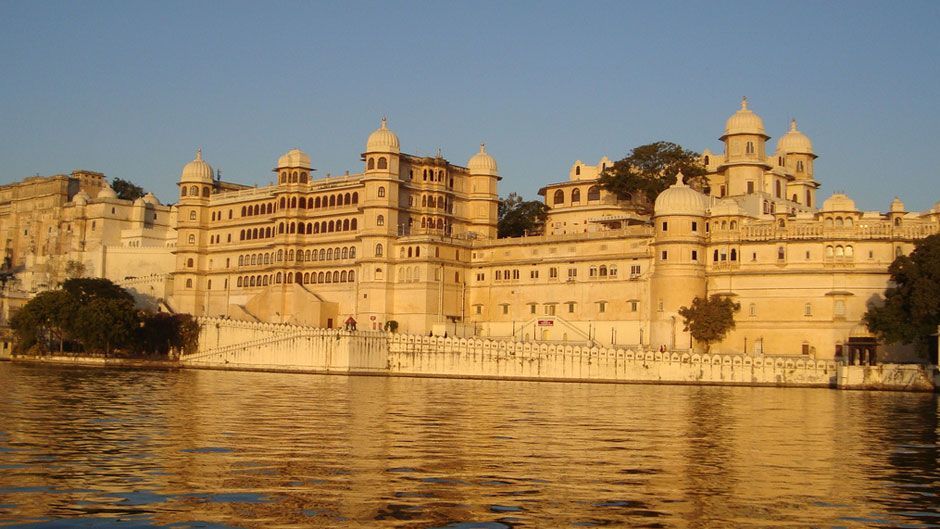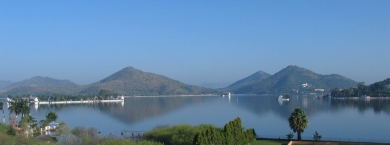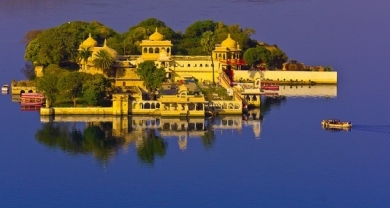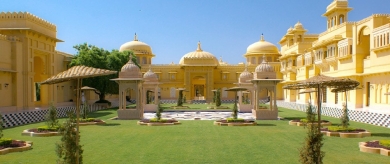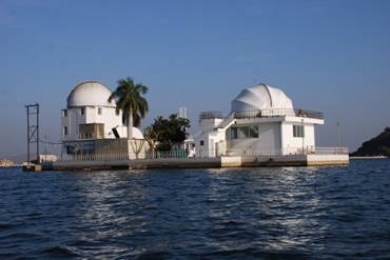Udaipur, the capital of the former princely state of Mewar is a beautiful city in Rajasthan, India. Udaipur city is also referred to as the "Venice of the East", the "Most Romantic City of India" and the "Kashmir of Rajasthan". Udaipur the “City of Lakes” is one among the most romantic and most beautiful cities of India. The city of Dawn, Udaipur is a lovely land around the azure water lakes, hemmed in by the lush hills of the Aravalis. A vision in white drenched in romance and beauty, Udaipur city of Rajasthan state is a fascinating blend of sights, sounds and experiences - an inspiration for the imagination of the poets, painters and writers. Udaipur's kaleidoscope of fairy-tale palaces, lakes, temples, gardens and narrow lanes strewn with stalls, carry the flavor of heroic past, epitomizing valor and chivalry. Their reflection in the placid waters of the Lake Pichhola is an enticing sight.
Most important places to Visit in Udaipur. / Sightseeing places in Udaipur.
Which all places I can visit along with Udaipur ?
Tour Itineries along with Udaipur.
Best time to visit Udaipur.
How to reach Udaipur ?
Most important places to Visit in Udaipur. / Sightseeing places in Udaipur.
City Palace
The City Palace museum is then entered through the Ganesh Deori meaning the door of Lord Ganesh. This leads to the RajyaAngan, the royal courtyard that is the very spot where MaharanaUdai Singh met the sage who told him to find a city here. The rooms of the palace are superbly decorated with mirror tiles and paintings. ManakMahal or the Ruby Palace has a lovely collection of glass and mirror work while Krishna Vilas display a rich collection of miniature paintings. MotiMahal or the pearl palace has beautiful mirror work and the ChiniMahal has ornamental tiles all over. The Surya Chopar or the sun square depicts a huge ornamental sun symbolising the sun dynasty to which the Mewar dynasty belongs. The Bari Mahal is a central garden with view of the city. Some more beautiful paintings can be seen in the ZenanaMahal or the ladies chamber, which leads to Lakshmi Chowk a beautiful white pavilion.
Ahar Museum
The Ahar Museum displays the royal cenotaphs and memorials of the Maharajas of Mewar. These cenotaphs are some of the most remarkable and noteworthy pieces of architecture exhibited in the Ahar Museum. There are a huge number of cenotaphs in Ahar Museum in Udaipur, India. There are about nineteen cenotaphs of the great Maharanas which are cremated there. Among all the cenotaphs in Ahar Museum, Rajasthan, one of the most striking cenotaphs is that of Maharana Amar Singh, who ruled during the period 1597 to 1620. The work of art attached to these cenotaphs are something to look out for. Whenever tourists visit Udaipur they should definitely go and visit the magnificent Ahar Museum, Udaipur for a lifetime experience.
Jagmandir Island
The other island palace, Jagmandir, was commenced by Maharana Karan Singh, but takes its name from MaharanaJagatSingh(1628-52) who made a number of additions to it. It is said that the Mughal emperor Shah Jahan derived some of his inspiration for the TajMahal from this palace, after staying here in 1623-24 AD while leading a revolt against his father, Jehangir. Flanked by a row of enormous stone elephant, the island has an impressive chhatri carved from grey-blue stone. The view across the lake, to the city and its glorious golden palace, is a scene of rare beauty.
BhartiyaLokMandal
Bhartiyalok Kala mandal was founded by Padma Shridevilalsamar in 1952. The main objective of the Institute is to conduct studies on the folk art, songs and festivals of regions like Rajasthan, Gujarat, Madhya Pradesh etc and to revive a vanishing folk culture. The institute has a puppet unit that trains children, teachers and other artists in the art of puppetry, as this is a very powerful non-conventional educative medium. It also boasts of regular performances that are a feast to behold. A group of 25 artists go on tour, both within India and abroad with a repertoire of puppet-shows and various folk dances. Their performances have brought the Institute a number of honours on a national and international level.
FatehSagar Lake
Udaipur tours are near incomplete without luxury tours to the manmade FatehSagar Lake located towards the north of the picturesque Lake Pichola.
FatehSagar was dug during the reign of Maharana Jai Singh in the year 1678 though Maharaja FatehSinghji reconstructed the water reservoir after heavy rains destroyed the FatehSagar Dam. FatehSagar is linked to the Rang Sagar Lake by a water canal.
Enjoy a boat cruise on the sparkling FatehSagar Lake that overlooks green hills and pleasant Udaipur vistas. One of the major tourist attractions of Udaipur, Rajasthan, India, theFatehSagar Lake captivates you with its myriad attractions. Watch spectacular sunsets as you enjoy a luxury boat cruise on the FatehSagar Lake in Udaipur, Rajasthan, India.
Tour the Nehru Park that is located on the banks of FatehSagar and pamper your taste buds at an exotic boat-shaped restaurant located close by.
Marvel at the Ram Pratap Palace located on the banks of the FatehSagar Lake and see the solar observatory that is located on a tiny island on the scenic FatehSagar Lake in Udaipur, Rajasthan, India.
Saheliyonki Bari
A spot once reserved for the royal ladies who strolled here, this well-planned garden is blessed with extensive and shady lawns on the banks of the FatehSagar Lake. The garden’s lotus pools and fountains show ancient science since they’ve been placed at a lower level than the Lake, thus being gravity-driven. The main fountain lies in the center on a white marble deck with black marble marking its four corners. On the western face are pavilions, delicately sculptured of black stone that are embraced by more fountains on all sides.
Jagdish temple
MaharanaJagat Singh built this temple between 1628-1653 at a whopping cost of Rs 1.5 million. Udaipur temple tour will take your to Jagdish temple, the famous temple of Udaipur, dedicated to Lord Jagannath, is at a great height and can be approached by a long flight of stairs.
The entrance to the temple is flanked by two massive stone elephants. The temple has a pyramidal spire (shikar), a vestible (mandap) and a porch. The spire is about 79ft high and is decorated with friezes of dancers, musicians, elephants and horsemen.
The temple is a three storeyed structure and has 50 pillars each in the first and second storeys and is one of the largest and popular Vishnu temples in Northern India.
The interior of the temple has exquisite carvings and is supplemented with prominent friezes. The temple has several smaller shrines in four corners of it that are dedicated to Lord Ganesh, Shiva, the Sun God and Goddess Shakti. A Sanskrit inscription in the porch written by Krishna Bhatt in the year 1651gives a detailed history of the reign of MaharanaJagat Singh. A huge brass image of Garuda, the vehicle of Lord Vishnu stands guard in front of the main shrine.
MotiMagir
MotiMagir or Pearl Hill overlooking FatehSagar is a statue of the Rajput hero MaharanaPratap, who frequently defied the Mughals. The path to the top traverses elegant gardens including a Japanese rock garden. The park is open daily 7:30 am to 7 pm.
Chittorgarh
The sprawling hilltop fort of Chittorgarhepitomises the whole romantic, doomed ideal of Rajput Chivalry. Thrice Chittor was sacked by a stronger enemy and on each occasion, the end came in textbook Rajput fashion as jauhar was declared in the face of impossible odds. The men donned the saffron robes of martyrdom and rode out from the fort to certain death, while the women and children immolated them self on a huge funeral pyre. Honour was always important than death.
Ranakpur
Beautiful sculptured Jain temples mark the glory of this renowned place. Marked as one of the five holy places for the Jain community, these were created in the 15 the century. During the reign of RanaKumbha and are enclosed within a wall. The central Chaumukha [four faced temple] is dedicated to Adinathji the temple is an astounding creation with 29 halls and 1,444 pillars all distinctly carved and no two being alike is a amazing evidence of the genius sense of architecture that enhances the charm of the place. Every temple has this conceivable surface carved with equal delicacy.
Eklingji & Nagda
Housing a manifestation of Shiva, the god who guards the fortunes of the rulers of Mewar, Eklingji is a lovely marble complex made up of 108 temples, the first of which was built in A.D. 734 by BappaRawal, legendary founder of the Sisodia clan, who ruled the Mewar kingdom for hundreds of years. The entire complex, most of it rebuilt in the 15th century, has a wonderfully uplifting atmosphere, particularly during prayer times , and never more so than on the Monday evenings when the Maharana of Udaipur is in town and comes to pay his respects here, walking among his subjects as a mere mortal despite the attendant bowing and scraping. The four-faced black lingam (phallic symbol) apparently marks the spot where BappaRawal (that's him riding the peacock) was given the title Darwan ("servant") of Eklingji by his guru; outside, facing Shiva, is Nandi, Shiva's vehicle. Wander around the temple complex and you'll find a number of carvings from the Kama Sutra; your explorations won't exceed 30 minutes. Deserted Nagda, which lies 2km (1 1/4 miles) north, is a far cry from this vibrant place of worship. All that survives of the site of the ancient capital of Mewar, which dates back to A.D. 626, are the ruins of the SaasBahu, a 10th-century Vaishnavite twin temple (Saas meaning "mother-in-law" and Bahu "daughter-in-law") and the remains of Adbhutji Temple. Regrettably, the temples have been vandalized over the years and look much the worse for wear -- unless you're of the archaeological bent, skip them if you're pushed for time.
Kumbhalgarh Fort
Kumbhalgarh Fort is the second most important fort of Rajasthan after Chittorgarh. Located at a distance of 64 kms from Udaipur in Rajasmand district, Kumbhalgarh Fort is easily accessible from the city of Udaipur. This unconquerable fortress is secured under the kind protection of the Aravali ranges. Kumbhalgarh Fort was built by MaharanaRanaKumbha in the 15th century. The fort derived its name from the same factor. Encircled by thirteen elevated mountain peaks, the fort is constructed on the top most ridges around 1,914 meters above sea level. The fortifications of the fort extend to the length of 36 kilometers and this fact has made this fort to be in the international records. It is stated to be the second longest wall in the world, the first being ''the Great Wall of China''. The huge complex of the Fort has numerous palaces, temples and gardens making it more magnificent.
Haldighati
Haldighati is an important historical site in the context of Rajasthan, India. Actually, Haldighati is a mountain pass in the Aravalli range connecting districts of Rajsamand and Pali in Rajasthan. The place is at a comfortable distance of 40 kms from the city of Udaipur. The term Haldighati has been derived from the yellow colored soil of the place that gives a sense of turmeric (in Hindi, turmeric is called as 'Haldi' and valley is known as' Ghati').
If you are interested in historic battles and heroic deeds of the courageous soldiers, then Haldighati is the perfect place to visit. Haldighati is a significant historical site that has observed the battle of 1576. The battle of Haldighati was a huge combat between RanaPratap Singh of Mewar and Raja Man Singh of Amber. This ferocious battle created amount of blood shed of the heroic soldiers and the red turned color of sand still speaks of those daring people.
Which all places I can visit along with Udaipur ?
Tour Itineries along with Udaipur.
Jaipur - Pushkar - Mount Abu - Udaipur
Jaipur - Chittorgarh- Udaipur - Mount Abu - Udaipur
Delhi - Mandawa - Bikaner - Jaisalmer - Jodhpur – Ranakpur - Udaipur - Pushkar - Jaipur – FatehpurSikri - Agra - Delhi
Jaipur - Jodhpur- Pushkar - Jaisalmer - Bikaner - Udaipur - Mount Abu
Jaipur - Jodhpur - Udaipur - Jaipur
Delhi – Agra – FatehpurSikri – Jaipur – Jodhpur – Ranakpur – Udaipur – Pushkar – Delhi
Delhi - Agra - Ranthambhore - Jaipur - Udaipur - Mumbai
Delhi - Agra - Samode - Jaipur - Udaipur - Delhi
Delhi - Mandawa - Bikaner - Jaisalmer - Jodhpur - Udaipur - Pushkar - Jaipur - Agra - Delhi
Delhi - Agra - Jaipur - Pushkar - Deogarh - Udaipur - Mount Abu - Jodhpur - Jaisalmer - Bikaner - Mandawa – Delhi
Delhi - Agra - Jaipur - Samode - Mandawa - Khimsar - Jaisalmer - Jodhpur - Udaipur - Delhi
Delhi - Samode - Mandawa - Bikaner - Jaisalmer - Rohet - Kumbhalgarh - Udaipur - Bijapur - Pushkar - Jaipur - Agra- Delhi
Delhi - Jaipur - Nimaj – Bassi - Khempur – Deogarh - Narlai – Kumbalgarh – Ahodi – Delwara – Devigarh – Udaipur – Devigarh – Udaipur – Mumbai
Mumbai – Bhavnagar – Palitana – Ahmedabad – Mount Abu - Udaipur – Rohetgarh – Jaisalmer – Bikaner - Jaipur – Agra - Delhi
Best time to visit Udaipur.
The best time to go to Udaipur is in the months between October to March as the weather conditions are ideal in the winter months to spend the entire day out exploring the city and sight seeing. The day time temperatures hover in the region of 30 degrees C and fall lower as the season progresses at this time of the year. Night temperatures tend to fall and at the height of winter in December - January can touch the 0 degree C mark.
The summer months between April and September are scorchingly hot and at the height of the summer season the mercury levels rise to touch the 43 degree C mark. The rains bring some relief in July but the weather is still hot and is now coupled with humidity.
The winter season sees the advent of many regional festivals that are celebrated with fervour and joy, with the colourfulMewar Festival being celebrated with a great amount of dancing and music heralding the coming of spring. This festival takes place sometime in March. If you happen to be in Udaipur during this time, it will surely be a treat!
How to reach Udaipur ?
How to Reach Udaipur by Air
MaharanaPratap Airport is 21 km from the city. Daily flights connect Udaipur to Jaipur, Jodhpur, Mumbai, Aurangabad and Delhi. Taxis and buses can both be used to cover the 40-minute journey from the airport to the city.
How to Reach Udaipur by Rail
There are rail connections to Delhi, Ahmedabad, Jaipur, Ajmer and Chittaurgarh and from there to all parts of India.
How to Reach Udaipur by Road
Wide network of bus services connects Udaipur to major to several destinations. Important distances – Agra – 630 km, Ahmedabad – 262 km, Jaipur – 406 km, Jodhpur – 275 km, Mount Abu – 185 km. Rent a car, share a cab, use a bus, take your pick.
Packages

9 Nights Rajasthan - 3 Star - Rs.55700
Udaipur Packages
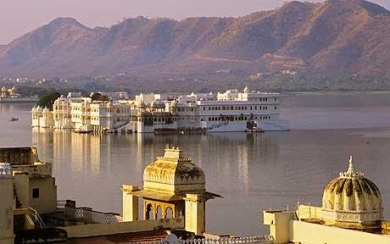
5 Nights Rajasthan - 3 Star - Rs.32700
Udaipur Packages
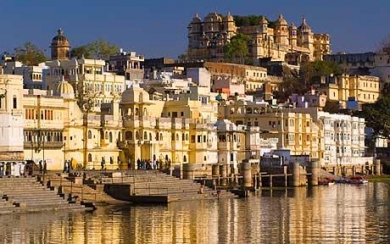
2 Nights Udaipur - 3 Star - Rs.16800
Udaipur Packages
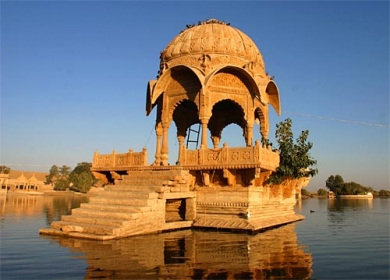
11 Nights Rajasthan - 3 Star - Rs.65300
Udaipur Packages
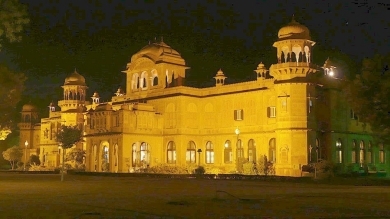
5 Nights Rajasthan - 3 Star - Rs.28500 - For 2 Adults
Udaipur Packages
